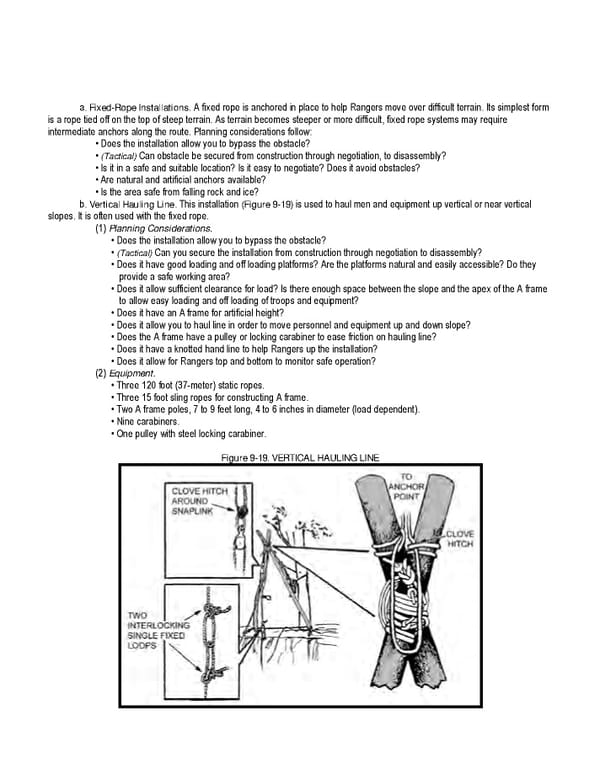a. Fixed-Rope Installations. A fixed rope is anchored in place to help Rangers move over difficult terrain. Its simplest form is a rope tied off on the top of steep terrain. As terrain becomes steeper or more difficult, fixed rope systems may require intermediate anchors along the route. Planning considerations follow: • Does the installation allow you to bypass the obstacle? • (Tactical) Can obstacle be secured from construction through negotiation, to disassembly? • Is it in a safe and suitable location? Is it easy to negotiate? Does it avoid obstacles? • Are natural and artificial anchors available? • Is the area safe from falling rock and ice? b. Vertical Hauling Line. This installation (Figure 9-19) is used to haul men and equipment up vertical or near vertical slopes. It is often used with the fixed rope. (1) Planning Considerations. • Does the installation allow you to bypass the obstacle? • (Tactical) Can you secure the installation from construction through negotiation to disassembly? • Does it have good loading and off loading platforms? Are the platforms natural and easily accessible? Do they provide a safe working area? • Does it allow sufficient clearance for load? Is there enough space between the slope and the apex of the A frame to allow easy loading and off loading of troops and equipment? • Does it have an A frame for artificial height? • Does it allow you to haul line in order to move personnel and equipment up and down slope? • Does the A frame have a pulley or locking carabiner to ease friction on hauling line? • Does it have a knotted hand line to help Rangers up the installation? • Does it allow for Rangers top and bottom to monitor safe operation? (2) Equipment. • Three 120 foot (37-meter) static ropes. • Three 15 foot sling ropes for constructing A frame. • Two A frame poles, 7 to 9 feet long, 4 to 6 inches in diameter (load dependent). • Nine carabiners. • One pulley with steel locking carabiner. Figure 9-19. VERTICAL HAULING LINE
 Ranger Handbook Page 183 Page 185
Ranger Handbook Page 183 Page 185